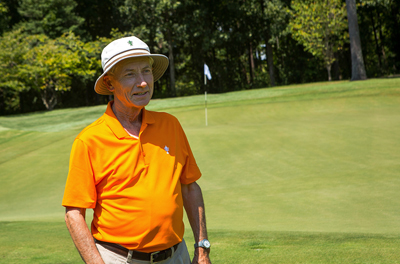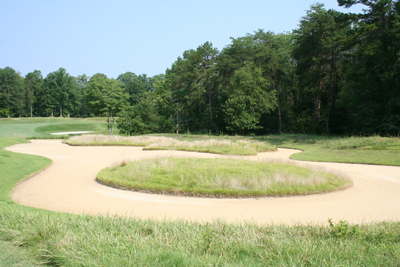From the November 2016 issue of GCM magazine:
Stepping stone
David Stone’s roots are firmly planted at The Honors Course, where he’s helped countless other superintendents get their careers off on the right foot as one of golf course management’s most respected mentors.

Photo by Bryan Pechacek/EPIC Creative
Scott Hollister
Read this story in GCM's digital edition »
Editor’s note: This article is part of a periodic series that highlights mentoring in the golf course management industry, and is presented in partnership with Syngenta and GCSAA TV. For more on the topic, visit The Mentor Channel at www.gcsaa.tv
David Stone climbs into his golf cart and wheels it away from the maintenance facility, pointing it toward the heart of a property he has managed since 1982, The Honors Course in Ooltewah, Tenn. The start of a popular member-guest tournament is looming in just a few hours’ time.
He has a visitor in tow, so ostensibly this trip is a guided tour of a course that is the centerpiece of a nearly 500-acre tract of land outside of Chattanooga and regularly ranks among the top 100 layouts in the country. But it’s also an opportunity for Stone to make one final check on preparations for the day’s event, and to greet members — some of whom have come from as far away as Atlanta and Nashville — who have already arrived for the tournament.

The Honors Course, designed by Pete Dye and carefully maintained by superintendent David Stone since 1982, is tucked seamlessly into 500 acres of wooded property just outside of Chattanooga, Tenn.
Photo by Ken May
The latter is a common practice among superintendents — shaking hands and welcoming golfers is just good customer service. What isn’t so common, though, is that at The Honors Course, it’s the members who regularly beat Stone to the punch, so eager to snag a minute of his time that they often get to him before he can get to them.
They stop his cart to talk about the Pete Dye-designed golf course. They seek him out in the clubhouse to chat about his beloved University of Tennessee football team. And they grab him to meet first-time guests to the golf course and to brag on Stone’s bird-watching prowess, a hobby that has led to the identification of more than 150 different species of birds on the property.
Such actions ooze with respect, and clearly show just how much the club’s membership thinks of their longtime director of agronomy and how much they appreciate all he has done for The Honors Course over the past four decades.
And it’s a respect that illustrates just how much they are going to miss him — at least, in the role he plays now — come the end of the year. That’s when Stone, a 42-year GCSAA member, will bring an end to his long and storied career in golf course management, trading his title as Honors Course superintendent for a new one as Honors Course member, a heartfelt thank-you from the club for his many years of service.

|
 |
|
Stone (above center) has built a sterling agronomic reputation
— one that has attracted countless young turfgrass managers
to work by his side — through years of experience managing bentgrass greens and zoysiagrass fairways in the heart of the transition zone.
Photos by Bryan Pechacek/EPIC Creative
|
“I don’t know that I ever thought I’d spend this long at any one place when I started my career,” says Stone, who turns 68 on Nov. 5. “But Mr. (Jack) Lupton (the club’s founder and owner) always said that The Honors Course was not a steppingstone to somewhere else. It was a stepping-off point. And he was right. This has been a special, special place in my life.”
Tennessee titan
If there is any group that holds Stone in higher regard than the members at The Honors Course, it’s probably his fellow golf course superintendents. For as much as he has given to the club that signs his paychecks, his peers in the industry say he’s given that much and more to golf course management as one of its most renowned teachers and mentors.
Jeff Hollister, the head superintendent at Chattanooga Golf and Country Club for the past 29 years and one of Stone’s early protégés, says, “You know how golf announcers will describe a great shot by saying, ‘You don’t know how good that shot really is’? Well, that’s David. Unless you’re in this industry, you don’t know how good he is. Just one of a kind.”
Courtney Young, CGCS, is the director of agronomy at Ansley Golf Club in Roswell, Ga., and did two tours as an intern under Stone at two different venues — Holston Hills Country Club in Knoxville, Tenn., and then The Honors Course — before becoming Stone’s assistant at the latter property from 1984 to 1986.
“For those of us lucky enough to soak up large doses of David’s teaching, the value of his counsel is just inestimable,” the 32-year GCSAA member says. “We have attained so much from David, and we all try to emulate him and his methods.”
“He is ‘the man’ in the state of Tennessee,” says Shelia Finney, a longtime superintendent in the state who went on to lead the Tennessee Turfgrass Association and now serves as GCSAA’s senior director of member programs. “His picture is in the hallway at (Tennessee) Golf House. He’s in the state golf hall of fame. If you’re in golf in Tennessee, you know of David and what he’s meant to the industry.”
Stone’s impact on others and the lessons he has shared have not been limited by state lines, though. Paul B. Latshaw, CGCS, the director of grounds operations at Muirfield Village Golf Club in Dublin, Ohio, spent the summer of 1986 and parts of the summer of 1987 interning under Stone at The Honors Course. And he did so at the insistence of another of golf course management’s legendary mentors: his father, Paul R. Latshaw, who will receive GCSAA’s Old Tom Morris Award in February.
“As far as a teacher and a mentor, David is just unbelievable,” the junior Latshaw says of his experiences in Ooltewah. “Whatever success I’ve had in my career was built on a foundation of the things I learned from people like David. Just a great agronomic mind.”
Early riser
Hearing accolades such as those and the deep appreciation that comes with them is certainly gratifying, Stone admits. He estimates that at least 20 of his former assistants now hold jobs as head superintendents, while countless other students, interns or course laborers who passed through The Honors Course at one time or another followed a very similar path. It’s also deeply humbling, considering that aside from his father and certain others along the way, he never really had any true mentors of his own as he made his way through the early days of his career.
“A lot of what I learned early on I learned from the workers, the guys in the trenches,” Stone says. “I remember one time when we were very short-handed and were skipping some greens mowing, doing them every other day, one of the best workers shook his head and said, ‘You can’t have good greens doing that.’ And he was right. I learned a lot from those guys, so I guess you could call them my first mentors.”
Not that Stone needed much inspiration to pursue a career in turfgrass management. As a 12-year-old growing up in middle Tennessee, he recalls pulling clumps of bermudagrass from the bunkers at the golf course at Henry Horton State Park and taking them home, nurturing them along in an attempt to grow his own backyard putting green.
At that point, his motivation was more about playing golf than it was tending to turf. But soon, those passions began to switch places, most notably after Stone read an article in a national golf magazine that mentioned the increasing popularity of college-level turfgrass degrees and the future superintendents who were pursuing them. After high school graduation, he joined those ranks at the University of Tennessee. “My dad thought it was a crazy idea,” Stone says. “He said, ‘You can’t make a living doing that.’”
But after graduating from Tennessee, that’s exactly what Stone did, first at Crockett Springs Golf Club (now known as Nashville Golf and Athletic Club), then at Holston Hills. It was at Crockett Springs that Stone got his first taste of managing bentgrass greens in the transition zone, a skill set that made him a bit of a rarity in that part of the world and, ultimately, one of the leading experts on the subject.
“I got a lot of help originally from Bill Kruger from Richland Country Club in Nashville, plus I learned a lot from trial and error,” Stone says. “Bill would come over, give me a few tips, and then I would kind of experiment on my own. That’s how I started being able to find dry spots in those bentgrass greens before they got dry enough to cause damage — just by checking the firmness of the green with a knife, knowing when to do hand watering and when not to.”
A house becomes a home
Stone’s experimental spirit (more on that later) would come into full bloom several years later when Stone made his move to The Honors Course. Exactly how that move came to pass is a story unto itself.
In the early 1980s, the development of a world-class golf facility in the hills outside of Chattanooga — with the late Lupton serving as owner/operator and Pete Dye as golf course architect — was the talk of the state’s golf business. Stone had heard the talk, of course, but had given it little thought until he was asked to play a round of golf at Holston Hills with Dye’s son, P.B., and several others who were working on the project at that time.

|
 |
|
The natural look of The Honors Course has been enhanced
over the years by Stone’s experimental nature. He tends to
a pair of nursery greens on the property that feature several bentgrass, bermudagrass and zoysiagrass varieties, and many
of those have made their way onto the course over time.
|
P.B. Dye must’ve liked what he saw in Stone, because a few months later, Stone received a phone call asking if he’d be interested in interviewing for the superintendent position at The Honors Course. “I had a job that I liked and really had no intention of moving,” Stone says. “But I wanted to meet Pete Dye and see the work they were doing, so I went.”
It was a life-changing decision. “The enormity of the project and what they were doing just blew me away,” Stone says. “But I still didn’t think I wanted to make the move, so when they asked, I told them I wouldn’t consider it unless they built me a house on the property.”
To Stone’s stunned surprise, Lupton thought that was a great idea. “At that point, it was a no-brainer,” he says, and for the past 35 years, he’s lived in that house, just a few hundred yards from both the maintenance facility and the nondescript main entrance to The Honors Course.
“This place has always just fit me,” Stone says. “I like to put in a lot of time on the golf course, and since I lived here on the property, I could go home when I wanted, come back here on the golf course when I wanted. I like Tennessee football, and Knoxville is 100 miles up the road, so I could go to games when I wanted. It just never made sense to look anywhere else.”
Lessons learned
Those who tutored at Stone’s side at The Honors Course over the years are certainly glad he stayed put. And regardless of when and how long they worked for Stone, the tales of what they took away from their experiences and what they still apply on the job today are remarkably similar.
Almost to a man, they mention Stone’s expertise in managing bentgrass greens in the heart of the transition zone as one of the reasons they strived for a spot at The Honors Course. It’s a sterling reputation that has persisted even after Stone led a conversion of The Honors Course’s greens to ultradwarf bermudagrass in 2013.
Will Misenhimer, Stone’s current assistant who will assume the top job at The Honors Course after Stone’s retirement (see “Heir apparent” on Page 47), says, “David was the premier bentgrass grower in the country, even being here in the Southeast, so that’s a big reason why I originally sought him out.”
Stone also hammered home to his charges the value of experimenting and the benefits it could deliver. He definitely practices what he preaches — at The Honors Course, Stone has not one but two large nursery areas where he cultivates a number of bermudagrass and zoysiagrass varieties (the fairways at The Honors Course are primarily Meyer zoysia) to see how they react to the climate and to various chemical applications and management practices.

|
 |
|
Since it opened in the early 1980s, The Honors Course has hosted numerous amateur tournaments, including four USGA national championships and the 1996 and 2010 NCAA Division I championships.
Photo by Ken May (top)/Photo courtesy of David Stone (bottom)
|
Most of his former protégés now exhibit that same passion for trial and error. “Agronomic practices have changed over the years, but how we attack problems hasn’t,” Young says. “David taught all of us to identify problems, think through the causes and solutions, and then test your hypothesis. And then most importantly, he taught us to share what we learned with others.”
Stone’s most important instruction, though, may have been his most basic: Remember the Golden Rule. “I always liked to say, ‘Don’t go around poking people in the eye and expect them to like you,’” Stone says. “It’s easy to be nice to people. And if you’re nice to people in this business, sooner or later, when you have a year when things aren’t so great on the golf course, those are the people who are going to stick with you.”
Mentoring matters
Over lunch following the previously mentioned tour of The Honors Course, Stone was asked why he got so much out of mentoring and why it became so important to him over the course of his long career.
“I realized early on just how important connections were,” Stone explains. “I’d visit other golf courses and talk to other superintendents, and it wouldn’t be any time at all before I’d hear from those courses or superintendents, asking me a question or even wanting to know if I was interested in a job. I never considered moving, but it illustrated right away that in our business, connections mattered. That’s something I always made a point to share with the people that worked for me and with me.”
It’s a lesson that has stuck with those who were mentored by Stone. “I’ve always enjoyed helping people reach their goals,” Hollister says. “It’s rewarding to watch young people coming into the business and fall in love with it the way I did. It’s something that’s important to me, and I know I have David to thank for some of that.”
“Let’s face it: This is a pretty humbling occupation,” Latshaw says. “You’re going to have trials and tribulations, and I think every superintendent has been humbled at some point. David is the type of person who was always available in those times. Anytime I had a question, I could call him and he’d answer. He just loves teaching people.”
Scott Hollister is GCM’s editor-in-chief.